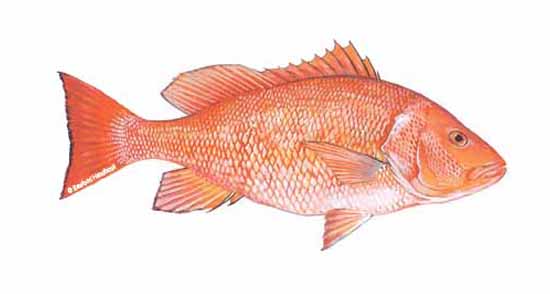Snapper
Published on
January 23, 2014

The name red snapper has been foisted off on just about any fish that is red. However, the FDA insists that only American red snapper, L. campechanus, can be legally shipped interstate bearing the authentic red snapper label. Beware of “snapper” sold on the West Coast; it could actually be rockfish, which has a completely different taste and texture. Red snappers grow to 35 pounds, although 4- to 6-pound fish are most common. Fish weighing 2 to 4 pounds have a metallic, pink skin. As they grow larger, their skin becomes redder. Many of the other snapper species are good eating, but they don’t have the trademark red skin and red eyes of the American red snapper. It also sports large, dog-like teeth, which are what give this fish its snapper name. The species is found from North Carolina to Florida’s “snapper banks,” off the coasts of Texas and Louisiana and down to the Campeche Bank off Mexico. Imports come from Mexico. Snapper is taken with longlines and sometimes by traps and trawls.
Lutjanus campechanus
Snapper
American red snapper, Red snapper, Caribbean red snapper, Mexican snapper
Vivaneau
Schnapper
Lutiano rosso
Tarumi feudai
Pargo de golfoo
The name red snapper has been foisted off on just about any fish that is red. However, the FDA insists that only American red snapper, L. campechanus, can be legally shipped interstate bearing the authentic red snapper label. Beware of “snapper” sold on the West Coast; it could actually be rockfish, which has a completely different taste and texture. Red snappers grow to 35 pounds, although 4- to 6-pound fish are most common. Fish weighing 2 to 4 pounds have a metallic, pink skin. As they grow larger, their skin becomes redder. Many of the other snapper species are good eating, but they don’t have the trademark red skin and red eyes of the American red snapper. It also sports large, dog-like teeth, which are what give this fish its snapper name. The species is found from North Carolina to Florida’s “snapper banks,” off the coasts of Texas and Louisiana and down to the Campeche Bank off Mexico. Imports come from Mexico. Snapper is taken with longlines and sometimes by traps and trawls.
Red snapper is lean and moist, with a sweetly mild but distinctive flavor. The texture is lean but moist. The superb taste of this fish is evidenced by the number of other types of fish that, with just the slightest hint of red, masquerade in the marketplace as “red” snapper.The semi-firm meat is pinkish, with yellow tones, in a raw state, turning somewhat lighter when cooked. The trademark skin is a deep red along the back, fading to a pinkish-red underside. To aid in identification, domestic American red snapper is almost always sold with the skin on.
| Calories: | 100 |
| Fat Calories: | 12 |
| Total Fat: | 1.3 g |
| Saturated Fat: | 0.3 g |
| Cholesterol: | 37 mg |
| Sodium: | 64 mg |
| Protein: | 20.5 g |
| Omega 3: | 0.4 g |
Red snapper responds well to just about any cooking method. Try steaming it whole, Chinese style. Some cooks also like to bake whole snapper stuffed with fresh herbs and seasonings. Skin-on American red snapper fillets shouldn’t curl during cooking, though that of other snappers will. That’s a disappointing way to find out you’ve paid full price for an imposter.
Grouper, Rockfish, Ocean perch
- Bake
- Boil
- Broil
- Fry
- Grill
- Pate
- Poach
- Saute
- Smoke
- Steam
Fresh: Whole, Dressed, H&G, Fillets (skin-on)
Frozen: Dressed, H&G, Fillets (skin-on)
Mexico, United States





